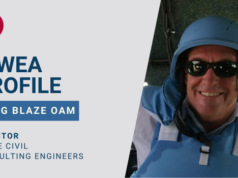While engineer Clarissa Campbell is the first to admit it was more by accident than design she ended up in engineering, the 30-something straight-talker wouldn’t have it any other way.
“I became an engineer by accident, to be honest,” says Clarissa. “I was studying education and science but decided that becoming a teacher wasn’t the right path for me and realised I enjoyed the engineering-related classes the most.
“When I was in high school, I thought I wanted to be a lawyer. But luckily, I didn’t take that path either.”
The Queenslander decided to enrol in engineering in a fast-tracked degree that saw her find her career feet for the first time. “I really enjoyed the classes, and knew I was on the right track straight away. Engineering is an industry that is different every single day and it’s a career I genuinely enjoy.”
Campbell’s in a small field. While the number of female engineers has increased, progress towards equality has been slow. In 2006, there were 21,174 women qualified engineers in the labour market. A decade later in 2016, this had grown by 112.4 per cent to 44,982.

While there’s still a lot of work to be done, the industry has welcomed news the Federal Budget has channelled $10 million into encouraging women in science, technology, engineering and mathematics (STEM) education.
Constructing an engineering career
At the time of starting her engineering degree there were two streams within civil engineering on offer – construction or environment and water – with women more likely to favour the latter.
Clarissa completed a Bachelor of Education/Bachelor of Science, graduating in 2012. She also has a Bachelor of Civil Engineering, Water and Environment, Physics, which she finished in 2014. Her degrees were obtained from the University of the Sunshine Coast, and she graduated feeling determined to pursue a career path offering exciting challenges.
As a student, she worked for nearly two years as a technical support officer for Sunshine Coast Council. The role involved mostly field work in the local council, learning the ropes. “Mostly, I was locating stormwater pipes and culverts and making sure their attributes were correct in council’s database,” she says.
Once she gained her engineering degree, Clarissa landed an engineering position with Moreton Bay Regional Council as a stormwater infrastructure engineer. “I was learning the ropes, and had responsibility for tasks alongside a small team of engineering professionals,” she says.

Within four years, she climbed through the ranks to senior engineer of stormwater infrastructure for the local government organisation. “I loved the work and learned a lot along the way during those years.”
She soon decided it was time for a new challenge, and applied for her current role as engineering design manager for global firm HDR. The company specialises in engineering, architecture, environmental and defence.
She started with HDR in February this year. While she commutes for an hour to the office in Brisbane, she’s in a consultancy role that teaches her something new every day.
Clarissa admits working from home between March and July due to the pandemic gave her more time in the day, which she loved. But working in an office environment among other engineers and technical specialists gives her experience that working from home could never offer.
“The first week we were all back in the office was like being back at school after the holidays,” she says. “There were so any people to talk to and catch up with.”
Knowing what’s needed
Clarissa works across HDR’s transportation and defence teams, but lately she’s been focused on infrastructure projects for local governments and the local road authority. And with her local government experience, she’s a welcome addition to the team, understanding what council wants in the bidding and delivery process.

“It’s interesting to be on the other side of the table of people I used to work with,” she says. “My experience at council taught me what to do, but it also taught me what not to do as a consultant.”
As a graduate, she has challenged herself and obtained highly sought-after positions. She admits industry connections – such as those derived through IPWEA – have played a big part in her career journey, along with a good work ethic. “I’ve also managed to be in the right place at the right time,” she says.
Maintaining her connections with industry peers has been an important part of her career development, with membership to IPWEA proving to be a professional lifeline. “Joining has been a great move for me because it’s allowed me to stay connected with others in the industry,” says Clarissa.
“The events have been great to meet engineers working in other fields.”
She is a strong advocate for women engineers because they bring a different and equally important perspective. “It’s the same as having a diverse group of people in teams,” she says. “It can only improve the outcome to have a variety of people involved in the decision-making process.”
Outside of work, Clarissa dabbles in archery and beekeeping, and loves taking her dog Frida to the beach. Lately she’s been spending most of her spare time renovating her house with her partner. The couple are replacing the bathroom, laundry and toilet and floorings in the property, and updating the kitchen and painting the house. Renovating is a new challenge, but then again, Clarissa loves opportunities for growth.
The renovation is also bringing out the best in her project management skills. “The deadline I’ve set is Christmas,” she says. “I’m hoping it provides motivation to finish the job so we can have Christmas at our house this year.”


















